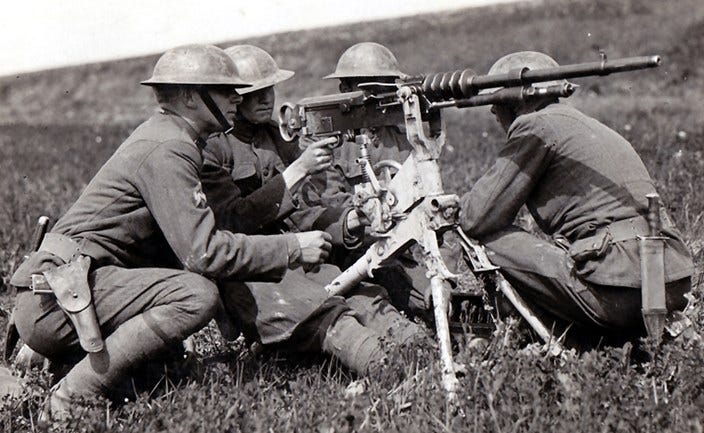Falklands 1914
The Zenith of the Battlecruiser
Like if you want using the keys below; only I can see who you are.
This was the ultimate expression of the “cruiser” concept.
After Coronel in November 1914 (remember?), the British Admiralty scrambled to meet the German threat posed by Maximilian von Spee’s still-intact cruisers. In response to the German threat, First Sea Lord Winston Churchill dispatched battlecruisers HMS Invincible and Inflexible, three armored cruisers, an armed merchant cruiser, and two light cruisers to the Falkland Islands, hopefully to intercept the German squadron of two armored cruisers, three light cruisers, two colliers and a supply ship before it could do too much more damage.
This is precisely why Fischer created the battlecruisers.
Invincible was the first battlecruiser ever built, and her sister ship Inflexible both carried eight 12-inch guns and could make up to 25 knots (just short of 30 MPH). These two alone were enough to outgun and outrun the German ships. The armored cruisers, older but added for maneuver weight, could barely keep up with their speedier consorts and their armament was puny in comparison. The light cruisers, newer than the armored cruisers, could only just keep up with the bigger ships.
The Germans were short on ammunition and hope.
Visiting Valparaiso, Chile, just after the Coronel battle, von Spee, on seeing a floral arrangement to be presented, remarked that they would look good on his grave. He had brought his ships that far east because he knew he couldn’t stay in the Pacific without a base. He also knew the British knew his location and destination, and that they would send a squadron, if not a fleet, to intercept him. Nonetheless, he put a brave face on it and hoped for the best as he headed into the Atlantic.
Hope is a good breakfast, but it is a bad supper.
Francis Bacon
Von Spee’s idea was to raid Port Stanley, perhaps grab some coal, and be in the mid-Atlantic before the British could find him. But the British squadron under Doveton Sturdee gathered at Port Stanley on 7 December, the day before the Germans reached it. Not seeing any British vessels in the early morning hours, von Spee’s ships approached the island in a fog. Just as they drew into gun range for the armored cruisers, the fog lifted enough for lookouts to spot the tall masts of heavy ships in Port Stanley Harbor. Veering off, von Spee led his ships away once again as the fog dissipated…and the British ships took off in pursuit.
Just as at Coronel, the issue was never in doubt.
The two battlecruisers worked out of the harbor as the other British vessels tried to head off the Germans. Engaging at extreme ranges for as long as they could, a cloud of 12-inch shells smothered von Spee’s vessels. Even if they didn’t always go off (a problem with large-caliber RN ammunition for much of WWI), they battered and bashed the lighter German ships. The lighter ammunition of the other British ships, however, had no such malfunctions. One by one, the British shot the German vessels to pieces while the Germans inflicted only minor damage on their opponents.
By early afternoon, the last of the German ships went under.
The architect of the Imperial German Navy, Alfred von Tirpitz, declared that a warship’s first duty is to float. To that end, German ships were better armored than their opponents, and could take more punishment. And they did. Even so, unable to do serious damage to the RN ships, the battle was a reversal of Coronel, with fewer than 20 British casualties to over 1,400 German, including von Spee and his son.
This was the last time battlecruisers fulfilled their initial mission: hunt down armored cruisers.
Steele’s Battalion: The Great War Diaries
Steele’s Battalion is based on the (fictional) diaries of Ned Steele, who joins the US Army in 1914, commissioned at the beginning of America’s entry in WWI, and rises to command a machine gun battalion in France.
A scholar finds Steele’s diaries in an old steamer trunk and transcribes them, verifying the entries as he does. Available starting 6 April 2025 from your favorite bookseller or from me if you want an autograph.
Coming Up…
The Great Machine Gun War
An Introduction to the American Civil War
And Finally...
On 14 December:
1542: James V of Scotland died in Falkland Palace, Scotland. Succeeding James was Mary I, age six days. Mary would take the throne officially in December 1560, and would reign until February 1567, when she abdicated while under arrest in England.
1964: The US Supreme Court handed down Heart of Atlanta Motel v. United States, finding that the hotel, and any public establishment, was subject to Title II of the Civil Rights Act of 1964, barring discrimination based on race.
And today is NATIONAL ALABAMA DAY, accidentally recognizing the 22nd state to enter the Union on this day in 1819.


